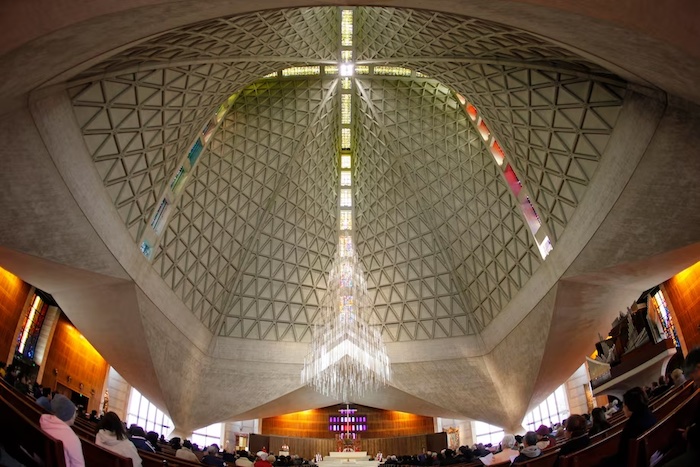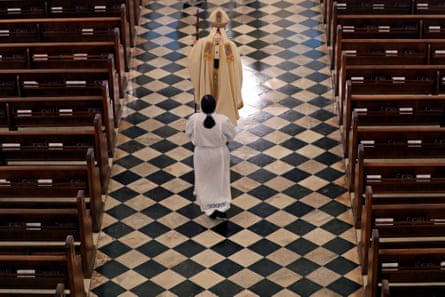
The Roman Catholic Archdiocese of San Francisco on Monday filed for Chapter 11 bankruptcy, saying it is necessary to resolve the more than 500 lawsuits of child sexual abuse dating back decades, prompting victim advocates to call the decision an attempt to deny justice and transparency for survivors.
The petition was filed in the U.S. Bankruptcy Court for the Northern District of California, Archbishop Salvatore J. Cordileone said Monday, arguing that it was the “best solution for providing fair and equitable compensation to the innocent survivors who have been harmed,” he said on the archdiocese website.

“The unfortunate reality is that the archdiocese has neither the financial means nor the practical ability to litigate all of these abuse claims individually,” he said.
“It is the best way to bring much-needed resolution to survivors while allowing the Archdiocese to continue its sacred mission to the faithful and those in need. We must seek purification and redemption to heal, especially survivors who have carried the burdens of these sins against them for decades,” the statement added.
Cordileone said the majority of the alleged abuses occurred from the 1960s into the ’80s and involved priests who are deceased or no longer in the ministry.
The announcement prompted criticism from advocates who argued it could “stonewall survivors of clergy sexual abuse from receiving proper justice under the lawsuits filed under the California Child Victims Act,” said Jeff Anderson, an attorney who represents more than 125 people suing the archdiocese.
In a statement posted on his firm’s website, Anderson called the archbishop’s decision “dangerous” and said it demonstrates his preference for “secrecy and self-protection.”
The archdiocese did not immediately respond to The Washington Post’s request for comment on Anderson’s accusation Monday afternoon. When asked about the bankruptcy filing, it deferred to the statement on its website.
Dan McNevin, a representative of the nonprofit Survivors Network of Those Abused by Priests, had also previously warned against harmful consequences of such move.
“San Francisco’s bankruptcy will stiff-arm survivors who have the courage to tell their stories,” he told the San Francisco Chronicle this month, when the newspaper reported on the archdiocese’s intent to seek the protections. “If it is allowed to stand, bankruptcy halts trials, testimony, legal discovery, and the release of the files of priests and other perpetrators that, if released could be used to assess who in the organization helped to cover up crimes.”
“It’s a double bottom line benefit; they keep their secrets and they keep more of their wealth,” McNevin told the Chronicle.
Anderson and other advocates have also questioned the archdiocese’s refusal to publish information about members of clergy accused of child sexual abuse.
A barrage of lawsuits came after California passed a 2019 law allowing people to bring claims for childhood sexual abuse that otherwise would have been barred due the statute of limitations. The law opened a three-year window allowing cases to be filed against nonprofit organizations through Dec. 31, 2022, leading to more than 500 civil lawsuits against the San Francisco Archdiocese, according to a Los Angeles Times article from late last year, and more than 3,000 lawsuits against the Catholic Church in the state, The Post reported last month.
In 2003, California became the first U.S. state to temporarily lift statutes of limitations for childhood sex abuse in the wake of the Catholic Church scandal.
>If approved, the Chapter 11 process would freeze legal actions against the archdiocese while it restructures its finances.
The archbishop said bankruptcy would cover only the corporate legal entity, the Catholic Archbishop of San Francisco, and not its 88 parishes and schools, which are independently managed and will continue to operate as usual. The archdiocese serves more than 442,000 parishioners in the counties of San Francisco, San Mateo and Marin.
The San Francisco Archdiocese’s move follows that of the Santa Rosa Diocese, which filed for bankruptcy in March amid sex-abuse lawsuits from 200 people. The Oakland Diocese announced in May that it had filed for bankruptcy amid more than 330 lawsuits.
According to the Catholic News Agency, more than two dozen dioceses in the United States have entered bankruptcy proceedings, most of them in the past decade.
Complete Article ↪HERE↩!







